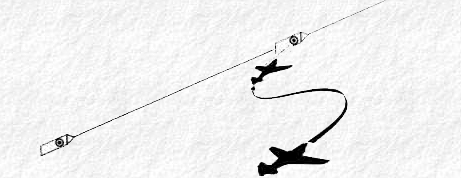|
HINTS ON GUNNERY It is not within the scope of this manual to deal with the science of aerial gunnery. Many excellent books, pamphlets. and tech orders have been written about gunnery-sources that you would be wise to consult. Unless you understand gunnery, unless you can hit your target, you are worthless as a fighter pilot. A fighter airplane is a flying gun platform. It has one purpose: to destroy the enemy. Similarly, all the training you have gone through up to now has had one purpose: to teach you to position your airplane for firing. The P-40, like all fighter airplanes, was designed for gunnery. |
If you observe the following rules while firing in the P- 40, you will find your gunnery techniques easy to master: 1. Fly smoothly while sighting at the target. 2. At the proper firing speed, trim the airplane to fly practically hands off. 3. Don't get too close to the target: you may mush into it on the pullout. 4. Never fire a burst at a tow target longer than 3 seconds; a longer burst is harmful to your guns. |
|
|
|
|
Three basic approaches are employed for firing at any target in the air. There are, of course, variations of each approach, but until you master the basic three you cannot become proficient at the variations. The three approaches are: |
|
 |
|
|
1. 90' SIDE APPROACH Posiiion your airplane so that the target is 45' behind you, about 800 yards out to the side. Make a steady progressive turn into the target until you reach a point 90' from the target's line of -flight and in the correct range. At this point bring your sight up to the target from behind, ready for sighting. Concentrate on the |
sight so that while you continue your turn, you draw the bead of the sight through the target until you have the correct deflection. When the range, line of flight, and deflection are all correct, fire. Note: Your must fly your airplane smoothly during the pay-off stage of the attack. |


